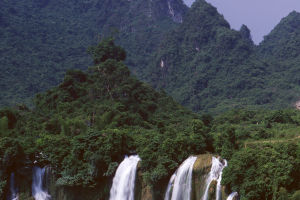The natural shoreline is a crucial ecological and environmental asset that should be protected and preserved to ensure the sustainable development of coastal zones.
It serves as the dividing line between the land and the sea, where land ecosystems and marine ecosystems intersect, creating a rich diversity of resources.
However, the natural shoreline is under threat due to human activities such as artificial shoreline beautification and solidification, which negatively impacts the ecosystem and biodiversity.
These activities also cause irreversible damage to the natural shoreline, which has been formed over thousands or even tens of thousands of years through erosion by high and low tides, typhoons, and other natural phenomena. Once destroyed, the natural shoreline can never be restored to its original state.
Rivers are often fully drained for navigation purposes, resulting in the destruction of their natural properties. Small ditches and streams, which were once full of life, with fish and shrimp that could be touched by hand, have been cured with concrete slabs, destroying their self-purifying ability and their biological habitats.
The extinction of fish and shrimp, the stench of the once-clear and beautiful waterways, and the deterioration of the ecological environment are just some of the consequences.
The sustainable development of coastal zones is an important element of regional sustainable development research, given the special importance of coastal zones to human beings and the earth system.
As a fundamental component of life support systems, the ocean contributes significantly to achieving sustainable development, and it is necessary to integrate the management and sustainable development of coastal zones and oceans, including exclusive economic zones, into the global sustainable development strategy.
The United Nations Agenda 21 has identified the integrated management and sustainable development of coastal zones and oceans as an important research area in the 21st century.
The ocean is a valuable asset that contributes significantly to achieving sustainable development, and it is crucial to protect and preserve the natural shoreline to ensure the sustainability of human activities and resource use in the coastal zone.
Global change is a major scientific issue and focus of attention for human society today, and the coastal zone is the most frequent and active zone on Earth where the hydrosphere, lithosphere, atmosphere, and biosphere interact with each other, responding most dramatically to global changes.
The International Geosphere-Biosphere Programme (IGBP) and the International Human Dimensions Programme on Global Environmental Change (IHDP) have made the study of land-sea interactions in the coastal zone one of their core projects, focused on the sustainability of human activities and resource use in the coastal zone, which has promoted the in-depth development of research on sustainable development in the coastal zone.
The land-sea interaction in the coastal zone is inseparable from global environmental change research and has become a key area for global change and regional sustainable development research. Scholars from various countries have paid great attention to the sustainability of human activities and resource use in the coastal zone.
The natural shoreline is a crucial ecological and environmental asset that should be protected and preserved to ensure the sustainable development of coastal zones. It is necessary to integrate the management and sustainable development of coastal zones and oceans, including exclusive economic zones, into the global sustainable development strategy.
The study of land-sea interactions in the coastal zone is crucial to promoting sustainable development in the region, and researchers from various countries must pay attention to the sustainability of human activities and resource use in the coastal zone to achieve global sustainable development.


